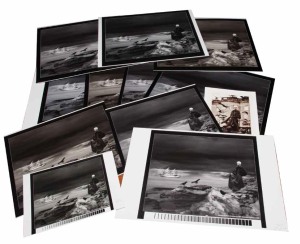articles/Monochrome/mike-mono-page10
Monochrome - choice of the connoisseurs - part 10 of 1 2 3 4 5 6 7 8 9 10 11
by Mike McNamee Published 02/02/2015

Papers for Monochrome
The idea of a paper specifically for monochrome is somewhat fanciful - the inkjet receptor layer is effectively colour blind caring only about the total ink loading and the mix of colours to produce a neutral (or in fact a tone). However, the question is one which is posed frequently and other magazines cobbled together lists so we thought, 'why not?' Do not lose sight as you read this, though that the fundamental question is flawed - any paper will take a monochrome, it depends on what you are looking for.
The baryta papers are the top contenders for a monochrome choice in that they most naturally resemble silver halide, air-dried fibre-base printswhich, in their day, were the ultimate expression of the monochrome art. The archetypal media were Ilford Galerie and Agfa Record Rapid.
There are currently 51 baryta papers on the Professional Imagemaker database (ie papers we have actually measured and printed onto) but rather than list all of them we have thinned the list down. So as to remain even handed we have taken a paper (or two) from each of the suppliers and arranged this so that representatives are listed right down the base-tone scale from warm tone to cool bright. Thus we have used base tone as the primary differentiator - this is reasonable because it has quite an influence on the look of a print and the numbers are simple to measure and handle.
So what does a quality monochrome print have? The depth of black is important, especially in prints which depend on rich shadows. The modern inkjet is capable of delivering a higher density than silver halide but, in truth, once you get darker than a Dmax of 2.2 things are not really differentiated all that well. If you listen to the monochrome geeks arguing on their forums you might not pick up on this, they seem obsessed with Dmaxs out to 2.6 - they must have x-ray eyes!
Monochrome enthusiasts have always been keen on toned prints, that is prints in which the neutrality of the tone scale is shifted to show subtle colour. Typically this might be sepia for a thiocarbamide toner, magenta for a selenium toner, blue for an iron toner, red for a copper toner and so on. This shift is easily obtained in Photoshop as the previous pages have shown. However, the one thing that a good mono print should have is neutrality when it is required. To appear neutral the tone of the inks must match that of the paper so a blue (cool) paper actually needscoolness to match. To some extent this is supplied by the underlying base tone of the paper - after all a white sky with just a ghosting of ink will be almost identical to the base paper colour. As you progress down the tone scale the ink takes over until, at the shadow end, the ink tone dominates. This of course assumes that metamerism is zero, which is never the case. The viewing light and the viewer's memory of it will bias the image tone slightly. This is less important today as the metamerism of the Epson printer's ink set is well under control and so the unpleasant shifts towards green that we used to see are rare today. Even so the eye is exquisitely sensitive to shifts in mid greys and so neutrality remains important.
Please Note:
There is more than one page for this Article.
You are currently on page 10
- Monochrome - choice of the connoisseurs page 1
- Monochrome - choice of the connoisseurs page 2
- Monochrome - choice of the connoisseurs page 3
- Monochrome - choice of the connoisseurs page 4
- Monochrome - choice of the connoisseurs page 5
- Monochrome - choice of the connoisseurs page 6
- Monochrome - choice of the connoisseurs page 7
- Monochrome - choice of the connoisseurs page 8
- Monochrome - choice of the connoisseurs page 9
- Monochrome - choice of the connoisseurs page 10
- Monochrome - choice of the connoisseurs page 11
1st Published 02/02/2015
last update 09/12/2022 14:56:44
More Monochrome Articles
There are 0 days to get ready for The Society of Photographers Convention and Trade Show at The Novotel London West, Hammersmith ...
which starts on Wednesday 15th January 2025





